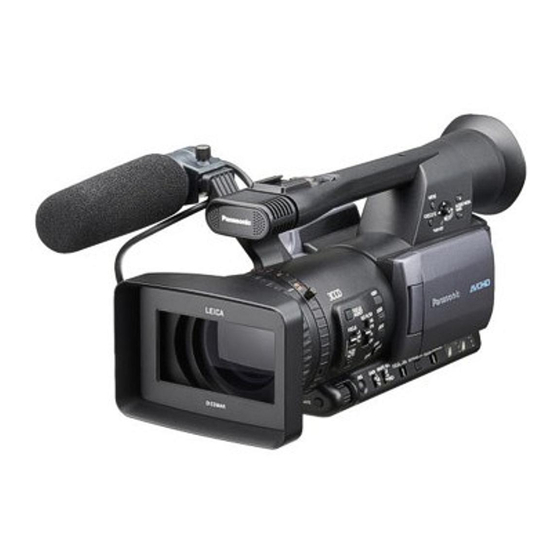Panasonic AG-HMC150 Kullanıcı Kılavuzu - Sayfa 34
Video Kamera Panasonic AG-HMC150 için çevrimiçi göz atın veya pdf Kullanıcı Kılavuzu indirin. Panasonic AG-HMC150 35 sayfaları. Avchd camcorder
Ayrıca Panasonic AG-HMC150 için: Broşür ve Teknik Özellikler (8 sayfalar), Bilgi menüsü (20 sayfalar), Broşür ve Teknik Özellikler (12 sayfalar), Broşür (16 sayfalar), Ürün Kılavuzu (22 sayfalar), Temel Talimatlar (20 sayfalar)

diffuse or "soften" hard edges; used especially for
close-ups to make the human face look more sensual
or glamorous.
Special effects (FX). Shots which are unobtainable
by straightforward lming techniques and may
require special models, compositing, computer
modeling, etc. e term also applies to most
pyrotechnic and ballistic effects in a lm.
Stop-motion photography. Filming real objects or
live action by starting and stopping the camera,
rather than by running the camera continuously, in
order to create pixilation, trick- lm effects, or time-
lapse photography. Also called stop-action
photography.
Subjective camera. See point-of-view shot.
Swish pan. A shot in which the camera pans rapidly
causing motion blur. Also called a whip pan or zip
pan.
SxS. A solid-state memory card used by Sony for
storage of video on some of their tapeless cameras.
Take. A shot resulting from one continuous run of
the camera. A lmmaker generally lms several
"takes" of the same scene and then selects the best
one. Rarely done in documentary.
Telephoto lens, a.k.a. long lens. A camera lens with
a long focal length that magni es the size of distant
objects.
Terabyte. One trillion bytes. A two hour high-
de nition movie at a resolution of 1920 x 1280
would take about one terabyte to store in an
uncompressed format. Acquisition formats like
DVCPRO HD, XDCAM HD, and HDV involve
signi cant levels of compression in order to reduce
the data required to store video.
Three-shot. A medium shot with three actors or
subjects.
Tilt. A shot in which the camera pivots vertically,
from top to bottom or from bottom to top.
Time Code. A time reference recorded on video tape
or a video le to identify each frame, typically written
or displayed as "02:23:43:02" designating hours :
minutes : seconds : frames. A semi-colon between the
seconds and frames typically indicates drop-frame
time code. See Drop Frame.
Time Code Break. Each time a tape-based camera
starts recording, it picks up the time code from the
last frame previously recorded and continues
counting up the numbers. A time code break occurs
when the recorder is not able to do this, and as a
Introduction to the Panasonic AG-HMC150 AVCHD camcorder (rough draft)
result, resets the time code to zero and counts up
from there while recording. is can confuse the
editing system upon capture, and therefore should be
avoided. see Capture.
Time-lapse. A type of cinematography or
photography in which the camera photographs at
time intervals the same scene over an extended period
of time in order to speed up on the screen a lengthy
process or action, for example, the growth of a eld
of corn, traffic on the Golden Gate Bridge, the
construction of a building, etc.
Tracking shot. A shot in which the camera,
mounted on a vehicle, dolly, or other moving
support device, moves while filming. Some
people differentiate tracking shots as those
following a subject as they move. Thus the
method of support and characteristic of the
movement determines the actual term used, for
example, we call it a dolly shot when a dolly is
used, we call it a tracking shot when tracks are
laid down for a dolly to roll on, though not
always true, for the most part, dolly, tracking,
traveling, and trucking shots are synonymous.
Trucking shot. See Tracking shot.
Two shot. A medium shot featuring two actors or
subjects.
Under-crank. To run lm stock through the camera
slower than the standard speed of 24 fps, producing
fast motion on the screen when the lm is projected
at standard speed. Also used to describe the analogous
effect in a video camera. See Over-crank.
USB (Universal Serial Bus). An interconnect standard
used to connect computers, hard drives, cameras,
scanners, printers, etc. USB (a.k.a. USB 1.0) is very
slow not at all usable with video, USB 2.0 (a.k.a. fast
USB) is widely used for connecting cameras and
external hard drives to a computer. Even though USB
2.0 appears on paper to be faster than Fire Wire, the
manner in which FireWire is implemented makes it a
faster interface and thus FireWire, especially FireWire
800 is favored by video editors for connecting
computers to external hard drives. A growing number
of tapeless cameras are using USB for data transfer
since the real-time performance of FireWire is not
required as it is with the DV or HDV formats.
VBR. Variable Bit Rate. A video compression method
in which the amount of compression is varied to
allow for minimum degradation of image quality in
scenes that are more difficult to compress. For
example, the MPEG-2 video compression used for
making DVDs is typically done using VBR.
http://kino-eye.com/dvb/
34 / 35
